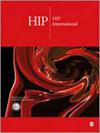Long-term outcomes of acetabular impaction grafting with cemented cups and trabecular metal for revision hip arthroplasty: a follow-up study
IF 1.1
4区 医学
Q3 ORTHOPEDICS
引用次数: 0
Abstract
Introduction:Revision hip arthroplasty in the presence of complex acetabular deficiencies is challenging. Cement, allograft, reconstruction rings and porous trabecular metal now provide versatile options for acetabular fixation and restoration of acetabular offset. We compare acetabular impaction bone grafting (AIBG) and trabecular metal (TM) cups at long-term follow-up.Methods:53 patients who underwent revision hip arthroplasty were retrospectively reviewed from local joint registry data. 36 patients were revised using AIBG and 17 with TM. Median clinical follow-up was 9.57 (2.46–18.72) years and 9.65 (7.22–12.46) years, respectively. 82% of the TM group and 63% of the AIBG group were ⩾ Paprosky 2C. Re-revision was considered failure. Radiographs demonstrating 5 mm of femoral head migration and 5° of acetabular component inclination change were considered loose.Results:Patients receiving AIBG were younger (68 vs. 74 years) with a longer interval from initial arthroplasty to revision (17 vs. 13 years). Revisions in both groups were indicated most commonly for failed cementing (AIBG 88.9% vs. TM 70.5%). No TM reconstructions underwent re-revision, with only 1 failing at 6.3 years, compared with 9 AIBG re-revisions. When revising for sepsis, 33% of AIBG revisions failed.Conclusions:AIBG demonstrated high failure rates at long-term follow-up when compared to TM constructs. We recommend the use of AIBG in small cavitary defects only. We strongly advise against its use in the setting of significant bony defects and for prosthetic joint infection.用骨水泥杯和小梁金属进行髋臼内陷移植翻修髋关节置换术的长期效果:一项随访研究
导言:在存在复杂髋臼缺损的情况下进行翻修髋关节置换术具有挑战性。目前,骨水泥、同种异体移植、重建环和多孔小梁金属为髋臼固定和恢复髋臼偏移提供了多种选择。我们对长期随访中的髋臼植入骨移植(AIBG)和小梁金属(TM)杯进行了比较。36例患者使用AIBG翻修,17例使用TM翻修。中位临床随访时间分别为9.57(2.46-18.72)年和9.65(7.22-12.46)年。82%的TM组和63%的AIBG组患者的Paprosky ⩾2C。再次修补被视为失败。结果:接受AIBG的患者更年轻(68岁对74岁),从初次关节置换到翻修的间隔时间更长(17年对13年)。两组患者中最常见的翻修原因都是粘接失败(AIBG 88.9% 对 TM 70.5%)。TM重建中没有再次翻修,只有1例在6.3年时失败,而AIBG中则有9例再次翻修。结论:与TM结构相比,AIBG在长期随访中显示出很高的失败率。我们建议仅在小腔隙缺损中使用AIBG。我们强烈建议在骨质严重缺损和假体关节感染的情况下不要使用AIBG。
本文章由计算机程序翻译,如有差异,请以英文原文为准。
求助全文
约1分钟内获得全文
求助全文
来源期刊

HIP International
医学-整形外科
CiteScore
4.20
自引率
0.00%
发文量
70
审稿时长
2 months
期刊介绍:
HIP International is the official journal of the European Hip Society. It is the only international, peer-reviewed, bi-monthly journal dedicated to diseases of the hip. HIP International considers contributions relating to hip surgery, traumatology of the hip, prosthetic surgery, biomechanics, and basic sciences relating to the hip. HIP International invites reviews from leading specialists with the aim of informing its readers of current evidence-based best practice.
The journal also publishes supplements containing proceedings of symposia, special meetings or articles of special educational merit.
HIP International is divided into six independent sections led by editors of the highest scientific merit. These sections are:
• Biomaterials
• Biomechanics
• Conservative Hip Surgery
• Paediatrics
• Primary and Revision Hip Arthroplasty
• Traumatology
 求助内容:
求助内容: 应助结果提醒方式:
应助结果提醒方式:


